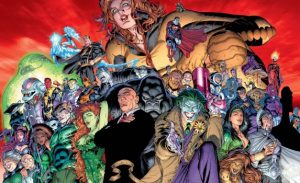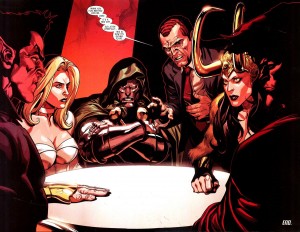
It has always been said that villains are more interesting than heroes. There’s something about the cathartic, fantasy wish-fulfillment of simply being bad that appeals to our darker natures. We may root for the hero, but secretly we crave more of the villain before his or her inevitable defeat. The villain also tends to be more nuanced than the hero, with reasoning and drive behind their goals beyond the simple “do good” edict of the hero.
And, as with most things, supervillains turn this up to eleven. For every superhero, there is a pantheon of colourful, multi-layered supervillains each with their own complex agendas. But in each rogues gallery there is one stand-out. One master villain who tasks the hero more than most. Whose very name inspires fear in the fearless. The standard by which all the other villains are judged. The nemesis.
Just what is it that makes a nemesis different from the other bad guys though? With DC Comics’ Villains Month in full effect this September, I thought I’d take a look at those on the wrong side of the law, and try to answer that question.
The most common thinking is that a nemesis is the equal but opposite of the hero. To use an example from outside of comics; Professor Moriarty is just as smart as Sherlock Holmes, except that he uses his genius to commit crimes rather than solve them.
A great case for this is the relationship between Batman and his nemesis, the Joker. Opposites in almost every way. Batman is dark, Joker is bright. Batman is grim, Joker is funny. Batman is calculating and logical, Joker is chaotic and unpredictable. Batman values all life, Joker sees life as worthless. And so, they are forever and always locking horns; like two forces of nature inseparably drawn together time and again.
However, this “opposites attract” theory has its drawbacks. It has given rise to the thought that a superhero’s nemesis must have the inverse of the hero’s powers as well. Firestorm and Killer Frost, for instance. Or that they must have equal abilities to the hero: Daredevil and Bullseye, Green Arrow and Merlyn. Many more modern superhero creators fall into this trap, but a nemesis’ greatness is not measured by how much of a match they are for the hero’s power, but in how they task the hero morally. A good nemesis (if you’ll ignore the non sequitor) should be a philosophical polar opposite to the hero.

As with Batman and the Joker, Superman and Lex Luthor are not evenly matched in strength or skill. So why then is Luthor so well known as the Man of Steel’s most persistent enemy? In the words of Big Blue himself, “It’s not because of his intelligence, or his wealth, or even because he is ‘evil’. It is simply because he cannot be humbled.”* That’s it in a nutshell. Superman is selfless and modest right to the core. Everything Luthor does is to further his own agendas, and he is incapable of seeing the wrong in himself.
Too many superhero creators, when trying to come up with a new “ultimate foe” ask themselves “what can the hero do?” and then go in the opposite direction. What they should ask is “who is this hero?” and then create someone in complete contrast. Someone whom, even if hero and villain met casually, would always find something to argue about.
Geoff Johns understood this during his time writing The Flash. The Scarlet Speedster’s nemesis, Captain Cold, may have been created under the erroneous “opposite powers” theory I mentioned above, but during Johns’ run he fleshed the Rogue out into a much better foil for his hero. In the Ignition storyline, an amnesiac Flash meets Cold in a diner. Both out of costume, neither recognizes the other, and they start up a conversation which eventually leads to the subject of good versus evil. Flash thinks people are essentially good, Cold thinks people are essentially bad. Polar philosophies. The perfect hero-nemesis relationship exemplified without the need for a fight scene. Many could learn from it.
Of course, there’s also the “former friend” type of nemesis. Once the hero’s closest ally and confidant, turned into their worst antagonist. Loki, Sinestro, Magneto, etc. However, they all stem from the “opposing philosophies” theory of supervillainy. Again though, many creators attempt to carbon copy these types, simply giving their hero a former companion turned evil, without understanding the deeper intent behind them.
This is why the best nemeses are not necessarily the ones who are a physical match for the hero, but rather the ones who represent everything the hero stands against.

*Very loosely paraphrased from Justice by Alex Ross and Jim Krueger.
















That was a nice read, the kinda article that makes me immediately want to dive back in to some comics.
The bad guys really are what make or break the comic (or any fiction, for that matter). Great analysis!
Sad thing is these days all out villains seem to have to have their back story re-written so that the reason they became bad guys is because they were picked on, abused, or they were 'sensitive' as children and no one understood them.
I prefer to have my villains be villains just because.